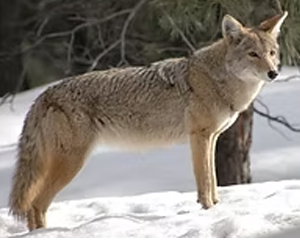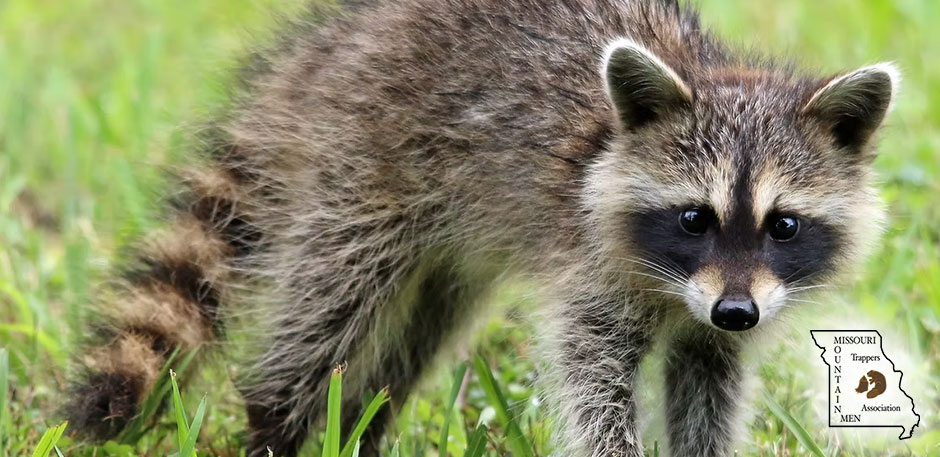Coyote - Commonly Trapped Furbearer
UTILIZING OUR ABUNDANT MISSOURI WILDLIFE

Coyote
Fast Facts
- Average weight: ~30 pounds
- Teeth: 42
- Mating season: February–March
- Gestation: 63 days
- Litter size: ~8–9 pups (in some areas)
- Female range: ~8 square miles
- Male range: up to ~40 square miles
- Life span: up to ~12 years
Coyotes are widely distributed throughout the United States. Efforts to contain wild populations have been only “temporarily” successful in spite of bounties, poisons, and a total lack of protection in many states. This species is very adaptable and can thrive in forests, farmlands, prairies, mountains, deserts, and swamplands. Coyote populations are known to exist in 46 states, and it is possible that coyotes will soon be present in all states except Hawaii. Coyotes can adapt to populated areas, and thousands of coyotes living within the city limits of Los Angeles have led to severe management problems. Coyotes frequently howl at night when they are not severely persecuted. :contentReference[oaicite:0]{index=0}
Description
Coyotes are wild canines with dog- or wolf-like features. Weights are slightly heavier for males, with average weights of about 30 pounds for males and 25 pounds for females in western states. The immigration of coyotes has affected eastern states since the early 1950s, and the eastern coyote is now recognized as a true breeding subspecies. Eastern coyotes do attain larger body weights than western coyotes, and this may reflect hereditary traits as a result of cross-breeding between northern coyotes and eastern timber wolves. Weights of over 60 pounds have been recorded for some eastern coyote males, though the majority weigh between 30 and 35 pounds. :contentReference[oaicite:1]{index=1}
Coyotes have 42 teeth, including four long incisor teeth. Eyes are yellow or amber with round black pupils, which indicate that coyotes were probably daytime hunters before man began persecuting the species in earnest. Guard hairs on a coyote pelt are about 3 inches long on the back and 5 inches long in a patch between the shoulders known as the “mane” or “hackles.” Coloration varies with individuals and regions—most coyotes are mottled grays with lighter bellies. Brownish and reddish colors also occur commonly, and melanism or black colors occur more rarely. :contentReference[oaicite:2]{index=2}
Reproduction
There is evidence to suggest that coyotes mate for life and that new mates are accepted after the removal of one of the pair. Mated male coyotes attend to the females who give birth to the annual litter in an underground den. A regular den is often used year after year unless the coyotes feel threatened at the den site. Breeding occurs in February in southern states and March in northern states. The gestation period is 63 days, and the female coyote will stay underground with her young until their eyes open (~11–12 days). During this time the male will bring food for the female and then help bring food to the den for the pups. Litter sizes average five to seven pups in many areas. Litter sizes seem to be dependent on coyote population densities. Litters may average eight or nine pups where coyote populations are sparse. :contentReference[oaicite:3]{index=3}
Habits
Coyotes are territorial during much of the year. Territory sizes vary greatly, and territories are far larger in areas where food is sparse. Males range much farther than females. Female coyotes will usually stay within 5 to 8 miles. Mature males may have territories as large as 30 to 40 square miles, which are patrolled on a regular basis. Territories are often abandoned during shortages of food. Several family units may concentrate in an area with abundant food supply for a short time. :contentReference[oaicite:4]{index=4}
Coyotes do have a social order, with certain individuals having dominance over others. At times, coyotes will hunt in packs or teams to chase running prey such as antelope or jackrabbits. Coyotes are even known to follow badgers to catch ground squirrels that are flushed from dens by the badger’s digging activity. :contentReference[oaicite:5]{index=5}
Diet
Coyotes are skilled hunters. Their vision, sense of smell, and hearing are all extremely good and enable them to feed easily throughout the year. In the extreme weather of mid-winter, coyotes frequently eat carrion. Significant numbers of deer and antelope fawns are killed by coyotes, especially in deep snow conditions when prey is more vulnerable. Sheep and calves can become prey when coyotes learn to kill them. As farmland becomes available, coyote predation on livestock may increase. Important coyote foods vary with the area and include jackrabbits, cottontails, prairie dogs, mice, rats, game birds, muskrats, squirrels, and domestic fowl. Fruits such as watermelons, grapefruit, apples, and persimmons are also eaten seasonally, if available. :contentReference[oaicite:6]{index=6}
Range
Coyote populations are known to exist in all states except Hawaii. They adapt easily to populated areas. :contentReference[oaicite:7]{index=7}
General
Coyotes contribute to the health of many prey species by keeping populations in check. Their scavenging of carrion helps reduce the population of injurious insects. However, they can cause significant losses to livestock producers in some areas. These losses amount to millions of dollars and cause hardships for many livestock operations. Western coyotes serve as hosts for fleas and ticks, which can carry diseases such as bubonic plague. Coyotes are also vulnerable to a variety of diseases, including parvo enteritis, mange, distemper, rabies, heartworms, and other internal and external parasites. Adult coyotes are rarely killed by other wild species; juveniles may be killed by eagles, mountain lions, and dogs. Ten to twelve years of age is considered old for a coyote. :contentReference[oaicite:8]{index=8}
Contact Missouri Trappers Association
Get in touch with the Missouri Trappers Association by filling out the contact form. We appreciate your support!
For questions regarding your membership, please call
Joslyn Search: (660)292-1911


